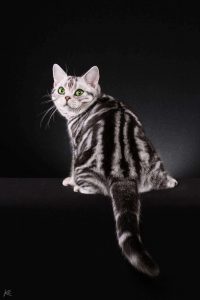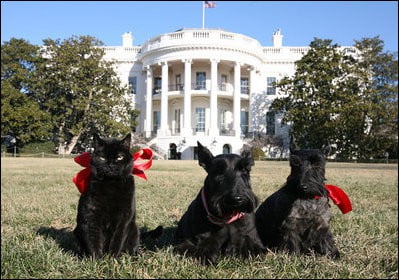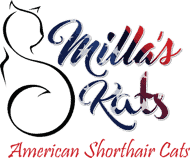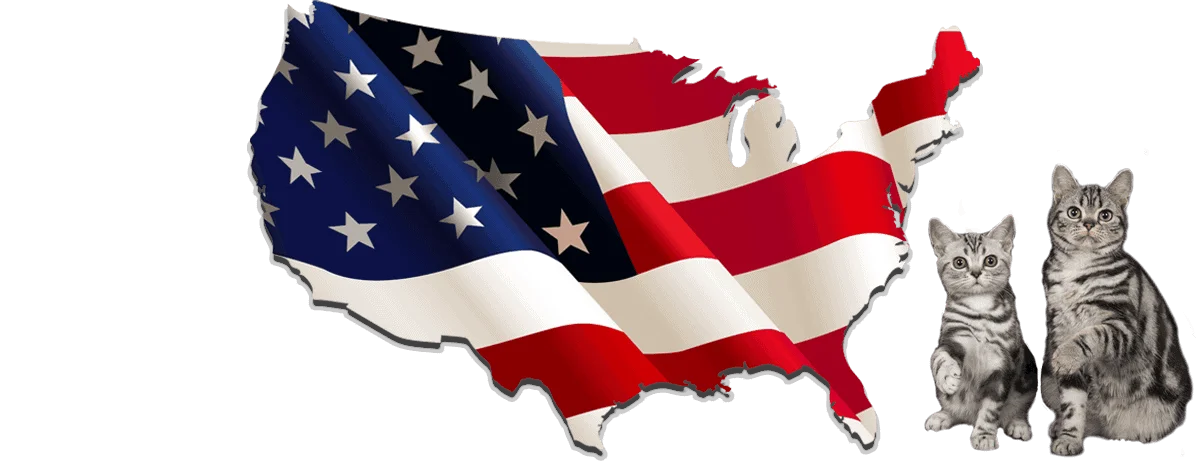History
History of the American Shorthair
Like so many other immigrants to the United States, the history of the American Shorthair has a rich and diverse history. It dates back to the arrival of European settlers in North America. Originally brought over as working cats on ships to control vermin, these cats quickly established themselves as valuable companions and hunters. Over time, they interbred with local feral cats, resulting in a resilient and adaptable breed.
The American Shorthair was recognized as an official breed in the late 19th century and gained popularity for its sturdy build, strong hunting instincts, and friendly temperament.
Today, the American Shorthair is cherished for its beauty, intelligence, and affectionate nature, making it a beloved household pet across the United States and beyond.
They had one job to do once they disembarked, to rid their homes, farms, and businesses of mice and other small vermin. There’s documentation in the history books that they came over on the Mayflower with the Pilgrims, and it’s likely that earlier settlers, such as those at Jamestown, also brought cats with them to the New World.
 During the 19th century, cat shows became popular and domestic shorthairs — as they were originally called — were exhibited alongside pedigreed cats.
During the 19th century, cat shows became popular and domestic shorthairs — as they were originally called — were exhibited alongside pedigreed cats.
Breeders eventually began the tedious process of selecting the right boys and girls for the specific traits that has now define the American Shorthair: a large head, a face with full cheeks and a sweet expression, a wide muzzle, a powerful jaw, and a coat of many colors, approximately 210. In 1966, the cats were given the name American Shorthair to differentiate them from random-bred felines.
They are now the fifth most popular breed registered by the Cat Fanciers Association. It’s clear that domestic cats first set paw in North America when the Europeans did, since North and South America have no indigenous species from which domestic cats could have developed. Since it was a common practice to keep cats aboard ships to deal with the ravaging rodents, cats may have been aboard the Niña, Pinta, and Santa Maria when Columbus sailed in 1492.
Cats were definitely present in Jamestown, the first permanent British colony in the New World; we know this because there is a written mention of cats dating from 1609. Who knows? Colonial cats might have snatched bits of turkey and venison off the table at that famous Plymouth Colony Thanksgiving feast in 1621.
Regardless of the history of the American Shorthair when they arrived and with whom, cats were working members of society rather than pampered pets, serving as perfect mouse traps in the barns and fields of colonial America. At this point, function was far more important than form, and folks paid little attention to the color, pattern, and body style of their mousers.
Through natural selection—life was hard on cats and humans alike—these feline immigrants developed powerful muscles, strong jaws, and hardy constitutions.
In the late 1950s, Domestic Shorthair breeders secretly began crossbreeding Persians into their Domestic Shorthair lines to “improve” the body type and to introduce the  striking silver color to their lines.
striking silver color to their lines.
As a result, the Domestic Shorthair body type began to change, becoming more Persian in style. Since Persians were (and still are) a very popular breed, these hybrids did well in the show halls.
As time passed, however, familiarity bred contempt for the breed. Fanciers became more interested in imported breeds such as the Persian, Siamese, and Angora than in the familiar Domestic Shorthair who had warmed their laps and served them faithfully for so many years.
And as these imports were crossbred with the Domestic Shorthair, the pure bloodlines of the American native began to be adulterated.
In the early 1900s, a group of people who loved the stalwart look of their valiant all-American cats began a selective breeding program to preserve the breed’s natural beauty, hardiness, and mild temperament.
They did allow the silver coloration to remain, however, since it brought a popularity not previously enjoyed by the breed.
At first, it was slow going and the breed received little respect from other cat fanciers. In the early days, not only did Domestic Shorthairs not win in the show ring against the exotic imports, but often cages were not even provided for the breed and no trophies or rosettes were presented to the Domestic classes. It wasn’t until the early 1940s that the breed began—slowly and with difficulty—to gain some recognition.
In September 1965, breeders voted to change the breed’s name from Domestic Shorthair to American Shorthair (abbreviated ASH). With the new name came a new image.
The same year, an American Shorthair silver tabby male named Shawnee Trademark won Best Cat of the Year in CFA, heralding a new era for the ASH.
Today, plenty of fanciers' pledge allegiance to this all-American breed, and you’ll see the ASH competing beside the finest Persians and Siamese and winning their share of awards. According to CFA’s breed registration totals, the American Shorthair is North America’s fourth most popular shorthair, and seventh most popular overall.
History of the American Shorthair with their Famous Owners
Abraham Lincoln, our sixteenth President, loved cats and could play  with them for hours. When asked if her husband had a hobby, Mary Todd Lincoln replied, “cats.”
with them for hours. When asked if her husband had a hobby, Mary Todd Lincoln replied, “cats.”
Given two kittens after his election by Secretary of State William Seward, President Lincoln named them Tabby and Dixie and he was known for serving them from the table during formal dinners at the White House.
According to the Presidential Pet Museum, President Lincoln would often say that “Dixie Is Smarter Than My Whole Cabinet.”
President Lincoln had a love for stray cats and would bring them home often. His son Eddy followed in his father's footsteps as Mary wrote in a letter telling her husband that he (Eddy) had taken up "your hobby."
President George W. Bush and First Lady Laura Bush acquired India, an all-black American Shorthair cat in 1991, for their twin daughters Barbara and Jenna when they were nine years old.
When their daughters left for college, India remained with the Bushes. In 2001 when India moved with the Bushes to the White House following Bush's presidential inauguration. India had two Scottish Terrier buddies named Barney and Miss Beazley.
India appeared on several White House videos produced by the House staff around Christmas, and she also made an appearance in March 2008 of Architectural Digest. India died on January 4, 2009; she was almost 19.


Paul McCartney had a great love for cats, he once had a trio of kittens named Jesus, Mary, and Joseph. Though not confirmed, it appears that the kitten is an American Shorthair kitten, marking, color, ear placing, eyes make it unmistakably an American Shorthair.



